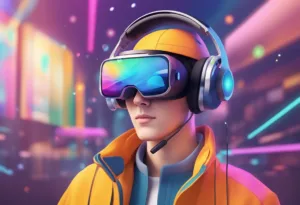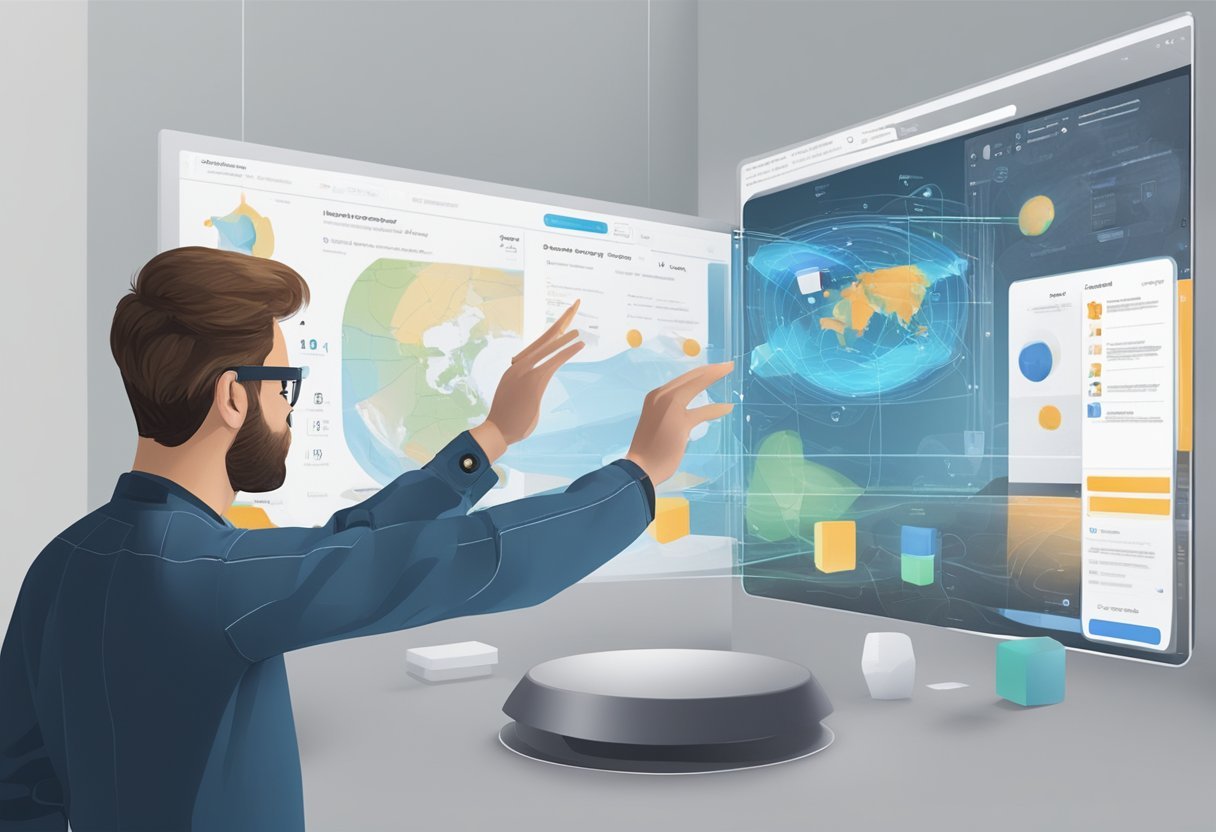Augmented Reality (AR) has been a buzzword in the tech industry for quite some time now. It has been used in various fields such as gaming, education, healthcare, and marketing. AR is a technology that overlays digital information on the real-world environment, enhancing a user’s perception and interaction with their surroundings. It is like a bridge between the physical and digital worlds that offers an immersive and interactive experience. In this blog post, I will discuss the question: How Does AR Work? and explain the funtionalities of Augmented Reality.
Fundamentally, AR works by using a camera or a sensor to capture the real-world environment, and then it overlays digital information on top of it. The digital information can be in the form of images, videos, or 3D models. AR can be experienced through different devices such as smartphones, tablets, smart glasses, and head-mounted displays (HMDs). The devices use sensors such as GPS, accelerometers, and gyroscopes to track the user’s position and movements, and then they adjust the digital information accordingly.
Key Takeaways
- AR technology overlays digital information on the real-world environment, enhancing a user’s perception and interaction with their surroundings.
- AR works by capturing the real-world environment and overlaying digital information on top of it.
- AR can be experienced through different devices such as smartphones, tablets, smart glasses, and head-mounted displays (HMDs).
Fundamentals of Augmented Reality

Defining AR
Augmented Reality (AR) is a technology that overlays digital information onto the real world. It enhances the user’s perception of reality by adding computer-generated sensory inputs. AR applications can be used on various devices such as smartphones, tablets, and wearable devices. AR technology has been used in gaming, education, healthcare, and other industries.
AR vs. VR: Differences and Similarities
AR and Virtual Reality (VR) are often confused with each other. However, they are two different technologies. Virtual Reality is a computer-generated simulation of a real or imaginary environment. It immerses the user in a completely digital world. On the other hand, AR overlays digital information onto the real world, enhancing the user’s perception of reality.
Both AR and VR have similarities. They both use computer-generated sensory inputs to enhance the user’s experience. They have been used in gaming, education, healthcare, and other industries.
How does AR work
AR technology uses a combination of hardware and software. The hardware includes devices such as smartphones, tablets, and wearable devices. The software includes AR applications that use computer vision, machine learning, and other technologies to overlay digital information onto the real world.
AR applications use the device’s camera to capture the real world. The software then analyzes the captured image and identifies the objects in it. It then overlays digital information onto the real world, enhancing the user’s perception of reality.
AR technology has come a long way in recent years. With the advancement of hardware and software, AR applications have become more sophisticated and useful. AR technology has the potential to revolutionize various industries, including gaming, education, healthcare, and more.
AR Technologies and Hardware

Core AR Hardware Components
AR technologies are built on a combination of hardware and software. The core hardware components that enable AR include cameras, sensors, processors, and displays. Cameras and sensors are used to capture the real world, while processors and displays are used to render and display virtual objects in real-time. These components work together to create a seamless AR experience.
Smart Glasses and Headsets
Smart glasses and headsets are a popular way to experience AR. These devices are designed to be worn on the head, and they typically include a display, camera, and sensors. The display is used to overlay digital content onto the real world, while the camera and sensors are used to track the user’s movements and the environment. Smart glasses and headsets are often used in industrial and enterprise settings, where they can be used to enhance productivity and efficiency.
Mobile Devices and AR
Mobile devices, such as smartphones and tablets, are another popular way to experience AR. These devices typically include a camera, sensors, and a display. AR applications can use the camera and sensors to track the user’s movements and the environment, while the display is used to overlay digital content onto the real world. Mobile devices are a popular way to experience AR because they are widely available and easy to use.
AR hardware is constantly evolving, and new devices are being developed all the time. As the technology improves, we can expect to see even more innovative AR hardware in the future.
AR Software and Platforms

Augmented Reality (AR) software and platforms are essential components in the development of AR applications. These tools provide developers with the necessary resources to create immersive AR experiences.
Software Development Kits (SDKs)
AR SDKs are software development kits that provide developers with the necessary tools to create AR applications. SDKs such as ARKit and ARCore are popular tools used by developers to create AR experiences. ARKit is a software framework developed by Apple for iOS devices, while ARCore is a software development kit developed by Google for Android devices. These SDKs provide developers with features such as motion tracking, environmental understanding, and light estimation, which are essential for creating AR experiences.
ARCore and ARKit
ARCore and ARKit are two of the most popular AR platforms used by developers. ARCore is a platform developed by Google that provides developers with the necessary tools to create AR applications for Android devices. ARKit, on the other hand, is a platform developed by Apple that provides developers with the necessary tools to create AR applications for iOS devices. These platforms provide developers with features such as motion tracking, environmental understanding, and light estimation, which are essential for creating AR experiences.
Custom AR Solutions
Custom AR solutions are AR applications that are developed by companies to meet their specific needs. Companies such as Wikitude provide custom AR solutions to businesses looking to create AR applications. These solutions are tailored to meet the specific needs of the business and can be used for a variety of purposes such as marketing, training, and education.
AR software and platforms are essential components in the development of AR applications. AR SDKs such as ARCore and ARKit provide developers with the necessary tools to create AR experiences, while custom AR solutions provide businesses with tailored AR applications to meet their specific needs.
Computer Vision in AR

Augmented Reality (AR) technology is based on a combination of computer vision and tracking techniques. Computer vision algorithms are used to identify and locate elements in the user’s environment, while tracking techniques are used to keep track of the user’s position and orientation in the environment.
Image and Object Recognition
Computer vision is a critical component of AR technology. It allows the system to recognize and understand the user’s environment, including the objects and surfaces in it. This is done through image and object recognition algorithms that analyze the visual data captured by the device’s camera.
Image recognition algorithms are used to identify patterns and features in the visual data, such as edges, corners, and textures. Object recognition algorithms go a step further by identifying specific objects in the environment, such as chairs, tables, and people.
Tracking and Mapping Techniques
To create a seamless AR experience, the system must be able to track the user’s position and orientation in the environment. This is done through a technique called simultaneous localization and mapping (SLAM). SLAM works by using the device’s camera and sensors to create a map of the environment. As the user moves around, the system updates the map and uses it to track the user’s position and orientation in real-time.
To improve the accuracy of tracking, the system may also use other tracking techniques, such as optical tracking and inertial tracking. Optical tracking uses visual markers to track the user’s position, while inertial tracking uses sensors to track the user’s movement.
Computer vision is a critical component of AR technology, allowing the system to recognize and understand the user’s environment. Tracking techniques, such as SLAM, are used to keep track of the user’s position and orientation in the environment, creating a seamless AR experience.
User Experience and Interaction

Designing for AR
Designing for AR requires a unique approach to user experience (UX) and interaction design. The goal is to create an immersive experience that blends the virtual and real world. The UX must be intuitive, easy to use, and provide a seamless transition between the physical and digital worlds. Designers must consider the user’s environment, the device being used, and the user’s goals.
User Interaction with AR
User interaction with AR is critical to the success of the experience. Gestures, voice commands, and touch are all common ways users interact with AR. The user’s environment and the device being used will dictate the types of interactions that are possible. For example, a smartphone may only allow touch interactions, while a headset may allow for voice commands and gestures.
Designers must consider the user’s comfort level with the technology and the environment in which they will be using it. The goal is to create a natural and intuitive experience that feels like an extension of the user’s physical world.
AR is an immersive experience that allows users to interact with digital elements in a physical environment. Designers must consider the user’s goals and the device being used to create a seamless and intuitive experience. By designing for AR, designers can create unique and engaging experiences that blend the virtual and real world.
Applications of AR
Augmented Reality (AR) has found its application in various fields, including gaming and entertainment, education, and industries. AR has also been used in healthcare, retail, and advertising.
AR in Gaming and Entertainment
AR has been widely used in gaming and entertainment. AR technology in gaming allows players to experience a game in a more immersive way. For instance, Pokemon Go, an AR game, allows players to catch Pokemon in the real world. AR has also been used in theme parks to enhance the visitor experience.
Educational Uses of AR
AR has been used in education to enhance learning experiences. AR technology has been used to create interactive learning experiences, making learning more engaging. For instance, AR technology has been used to create virtual field trips, allowing students to explore different places without leaving the classroom.
Industry-Specific Applications
AR has been used in various industries to improve efficiency and productivity. In healthcare, AR has been used to train medical professionals and to improve patient outcomes. In retail, AR has been used to enhance the shopping experience by allowing customers to try on clothes virtually. AR has also been used in advertising to create interactive advertisements, making them more engaging.
The Future of Augmented Reality
As technology continues to advance, the future of augmented reality (AR) is looking brighter than ever. With the rise of mixed reality and the metaverse, AR is poised to play a significant role in the way we interact with the digital world.
Trends in AR Technology
One of the most significant trends in AR technology is the development of more advanced hardware. With the release of devices like the Microsoft HoloLens and Magic Leap One, AR is becoming more immersive and realistic. These devices use advanced sensors and cameras to track the user’s movements and create a seamless AR experience.
Another trend in AR technology is the integration of AI and machine learning. As these technologies continue to advance, AR applications will become more intelligent and personalized. For example, an AR app could use machine learning to recognize objects and provide helpful information about them.
The Role of AR in the Metaverse
As the concept of the metaverse becomes more mainstream, AR is poised to play a significant role in its development. The metaverse is a virtual world where users can interact with each other and digital objects in a shared environment. AR technology can be used to create a seamless transition between the physical and digital worlds, allowing users to interact with the metaverse in a more immersive way.
AR could also play a significant role in the development of virtual commerce. With AR technology, users could try on virtual clothing or see how furniture would look in their homes before making a purchase. This could revolutionize the way we shop online and make it a more personalized and interactive experience.
The future of AR is looking bright, with advances in technology and the rise of the metaverse. As AR technology continues to evolve, we can expect to see more innovative applications and use cases for this exciting technology.
Frequently Asked Questions

What are the basic principles behind augmented reality technology?
Augmented reality (AR) is a technology that overlays digital information, such as images, sounds, and text, onto the real world. The basic principles behind AR technology involve the use of sensors, cameras, and software to detect and track real-world objects and surfaces, and then overlay digital content on top of them. This technology is often used in mobile devices, such as smartphones and tablets, and wearable devices, such as smart glasses and helmets.
What are some common applications and examples of augmented reality in use today?
AR technology is used in a wide range of applications, including entertainment, education, advertising, and healthcare. Some common examples of AR in use today include mobile apps that allow users to try on virtual clothing or makeup, games that overlay digital content onto the real world, and medical devices that use AR to guide surgeries and other procedures.
What advantages does augmented reality offer over traditional media and interfaces?
AR offers several advantages over traditional media and interfaces. For example, AR allows users to interact with digital content in a more immersive and engaging way, by overlaying it onto the real world. AR also allows users to access information and content in real-time, without the need for additional devices or interfaces. AR can be used to enhance safety and efficiency in a variety of industries, by providing workers with real-time information and guidance.
How do mobile devices, like iPhones, utilize augmented reality features?
Mobile devices, like iPhones, utilize AR features through the use of sensors, cameras, and software. These devices are equipped with cameras and sensors that allow them to detect and track real-world objects and surfaces, and then overlay digital content on top of them. Mobile apps that use AR technology typically require users to point their devices at a specific object or surface, in order to activate the AR features.
What is involved in creating an augmented reality application or game?
Creating an AR application or game typically involves several steps, including designing the user interface and experience, developing the software and algorithms that enable object recognition and tracking, and integrating the AR features into the app or game. This process can be complex and time-consuming, and may require specialized knowledge and skills in areas such as computer vision, machine learning, and graphics programming.
Can you explain the difference between augmented reality (AR) and virtual reality (VR)?
AR and VR are both immersive technologies that allow users to interact with digital content in a more engaging way. However, the main difference between AR and VR is that AR overlays digital content onto the real world, while VR creates a completely virtual environment that users can interact with. AR is typically used in applications that require users to interact with the real world, while VR is used in applications that require users to be fully immersed in a virtual environment.




